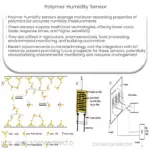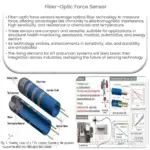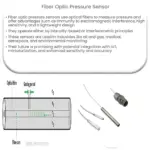Fiber-optic humidity sensors offer accurate, real-time environmental monitoring, with immunity to EMI, high sensitivity, and IoT integration.

Fiber-Optic Humidity Sensors: A Revolution in Environmental Monitoring
Introduction
Humidity plays a crucial role in various industries, including agriculture, healthcare, food processing, and electronics manufacturing. Accurate and real-time measurement of humidity is vital for maintaining optimal conditions and ensuring high-quality products. Fiber-optic humidity sensors have emerged as a groundbreaking technology in the field of environmental monitoring, offering numerous benefits over traditional humidity sensors. In this article, we explore the working principles, advantages, and potential applications of fiber-optic humidity sensors.
Working Principle
Fiber-optic humidity sensors operate based on the changes in the optical properties of certain materials when exposed to different humidity levels. These materials, known as humidity-sensitive materials, are typically coated onto the end of an optical fiber. When light is transmitted through the fiber, it interacts with the humidity-sensitive coating, leading to a change in the intensity or wavelength of the light signal. By measuring this change, the sensor can determine the humidity level in the surrounding environment.
Various humidity-sensitive materials can be used in fiber-optic humidity sensors, such as polymers, metal oxides, and porous glasses. The choice of material depends on the specific application and desired sensitivity range. Some sensors use a combination of materials to achieve enhanced performance and a wider range of humidity measurement.
Advantages of Fiber-Optic Humidity Sensors
Fiber-optic humidity sensors offer several advantages over conventional electronic-based sensors, including:
- Immunity to Electromagnetic Interference (EMI): Fiber-optic sensors are immune to electromagnetic interference, making them ideal for use in environments with high levels of EMI, such as power plants and telecommunications facilities.
- High Sensitivity and Accuracy: These sensors provide high sensitivity and accuracy in humidity measurement, ensuring precise monitoring in critical applications.
- Long-term Stability: Fiber-optic sensors exhibit long-term stability and minimal drift, ensuring reliable measurements over extended periods.
- Compact Size and Lightweight: Due to their small size and lightweight construction, fiber-optic sensors can be easily integrated into existing systems without requiring significant modifications.
- Safe for Use in Hazardous Environments: Since they do not generate sparks or heat, fiber-optic sensors are safe for use in potentially explosive or flammable environments.
Potential Applications
With their unique properties and benefits, fiber-optic humidity sensors find applications in various industries, such as:
- Agriculture: Monitoring humidity levels in greenhouses, soil moisture management, and controlling irrigation systems.
- Healthcare: Maintaining optimal humidity levels in hospitals and laboratories, preserving the integrity of medicines and medical equipment.
- Food Processing: Ensuring proper storage conditions for perishable food items, maintaining humidity levels during food production and packaging.
- Electronics Manufacturing: Controlling humidity levels in cleanrooms and fabrication facilities to prevent damage to sensitive electronic components.
In the following section, we will discuss recent advancements in fiber-optic humidity sensor technology and their potential impact on the future of environmental monitoring.
Recent Advancements in Fiber-Optic Humidity Sensor Technology
Researchers and engineers are continuously striving to improve the performance and capabilities of fiber-optic humidity sensors. Some recent advancements in this field include:
- Improved Sensitivity and Response Time: The development of novel humidity-sensitive materials and coatings has led to significant improvements in sensitivity and response time, allowing for faster and more accurate humidity measurements.
- Multi-Parameter Sensing: Advanced fiber-optic sensors are being developed that can simultaneously measure multiple environmental parameters, such as humidity, temperature, and pressure, using a single optical fiber. This multi-parameter sensing capability simplifies system design and reduces overall cost.
- Integration with IoT Systems: Fiber-optic humidity sensors are being integrated into Internet of Things (IoT) systems, allowing for remote monitoring and control of environmental conditions in real-time. This integration enables data-driven decision-making and enhances efficiency in various industries.
- Wearable Sensors: The development of flexible and wearable fiber-optic sensors has opened new avenues for personal health monitoring and environmental sensing applications. These wearable sensors can continuously monitor humidity levels, enabling individuals to track their exposure to different environmental conditions.
Future Prospects and Challenges
As fiber-optic humidity sensor technology continues to advance, we can expect to see increased adoption in various industries and applications. The ongoing integration of these sensors with IoT systems and the development of wearable sensors have the potential to revolutionize environmental monitoring and personal health tracking.
However, some challenges remain that must be addressed to further improve the performance and reliability of fiber-optic humidity sensors. These challenges include:
- Cost: The relatively high cost of fiber-optic sensors, as compared to traditional electronic sensors, may hinder their widespread adoption, especially in cost-sensitive applications. Further research and development are needed to reduce the cost of these sensors while maintaining their performance advantages.
- Standardization: The lack of standardization in fiber-optic sensor design and manufacturing may lead to inconsistencies in performance and compatibility issues. Industry-wide standards and guidelines need to be established to ensure the quality and reliability of these sensors.
- Material Degradation: The long-term stability and performance of fiber-optic humidity sensors can be affected by the degradation of humidity-sensitive materials, especially when exposed to harsh environmental conditions. Research is ongoing to develop materials with improved stability and resistance to degradation.
Conclusion
Fiber-optic humidity sensors have emerged as a revolutionary technology in the field of environmental monitoring, offering numerous benefits over traditional electronic sensors. With recent advancements in sensitivity, response time, multi-parameter sensing, and integration with IoT systems, these sensors are poised to play a crucial role in various industries, such as agriculture, healthcare, food processing, and electronics manufacturing. As research and development continue, we can expect to see further improvements in performance, reliability, and affordability, paving the way for a new era of environmental monitoring.




